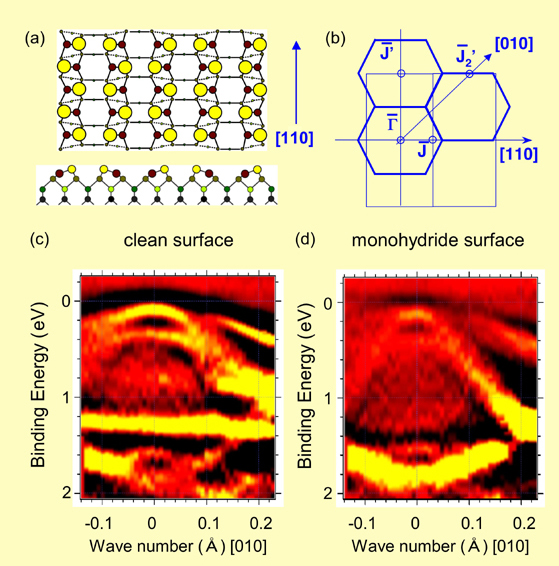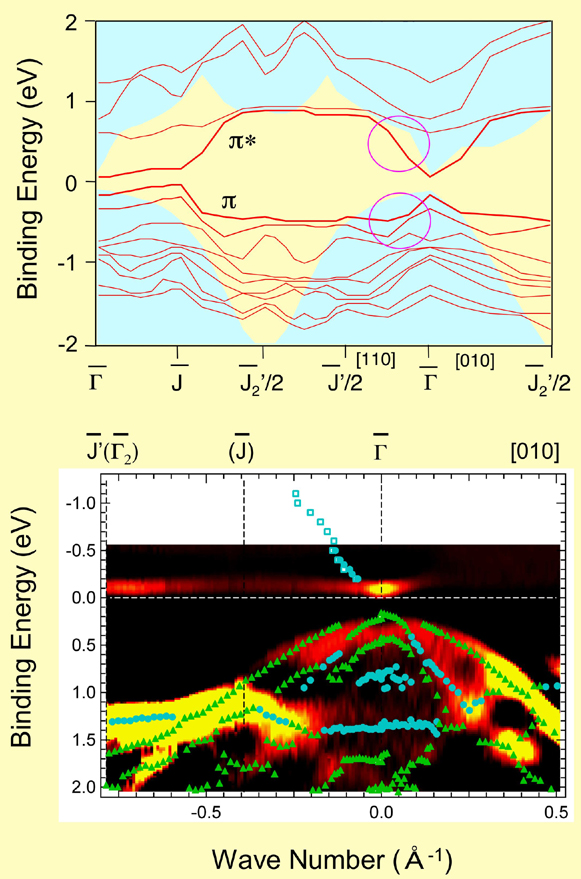Electronic states of clean Ge(001) surface
K. Nakatsuji, Y. Takagi, F. Komori, H. Kusuhara and A. Ishii
The dangling bond states of the clean Ge(001) surface plays important roles in various dynamical phenomena at the surface, such as chemical reaction and electronic excitation. Recently, hot carrier dynamics is discussed on the basis of a topological defect motions induced by its local tunneling injection from the STM tip into the surface states [1]. However, the previous theoretical and experimental studies on the electronic structure were insufficient for the discussion on such hot carrier dynamics. Thus, we have investigated it using the band calculation based on the first-principles method, high-resolution ARPES and standing wave observations by STM [2].
The atomic structure of this surface is c(4x2) in the ground state as schematically shown in Fig. 1(a). The calculated surface band structure for this superstructure is shown in the upper panel of Fig. 2. The dangling bond empty pi* band is in the bulk band gap while the dangling bond filled pi band is a resonance with the bulk states near Gamma point.
The valence band structure was measured by ARUPS. We found that the top band at Gamma point remains after adsorption of hydrogen atoms on the surface while the surface states clearly disappear as shown in Figs. 1(c,d). At temperatures higher than 470 K, the bottom of the pi* band in the bulk band gap is thermally filled, and almost flat dispersion is detected by ARPES along the dimer-axis direction [Gamma-J] as in the lower panel of Fig.2. A large dispersion of the pi* band in the direction perpendicular to the dimer-axis [Gamma-J'] is obtained from the analysis of the standing waves observed at 80 K in differential conductance images of STM. All these experimental results agree well with the band calculation.

Fig.1 (a) a schematic model of the c(4x2) surface structure. (b) The surface Brillouin zones for the c(4x2) (thick lines) and p(2x1) (thin lines) surfaces. (c,d) band dispersion around ¡ observed at 130 K for the clean (c) and H-adsorbed (d) Ge(001) surfaces by ARUPS

Fig.2 Upper; Surface band structure for the clean Ge(001)-c(4x2) surface. The axes are defined for the 2x1 surface shown in Fig. 1(b). Blue areas indicate the bulk bands projected to the surface. Lower; band dispersion observed at 680 K for the clean Ge(001) surface by ARUPS. Solid blue circles and green triangles indicate the surface and bulk states detected at 130 K. Open blue circles and squares above EF are the states in the¡-Jf direction determined from the standing wave observation for the c(4x2) (circles) and p(2x2) (squares) surfaces
References
1. Y. Takagi, Y. Yoshimoto, K. Nakatsuji and F. Komori, J. Phys. Soc. Jpn. 72, 2425 (2003), 74, 3143 (2005), Surf. Sci. 593, 113 (2005).
2. K. Nakatsuji, Y. Takagi, F. Komori, H. Kusuhara and A. Ishii: Phys. Rev. B72, 241308(R) (2005).